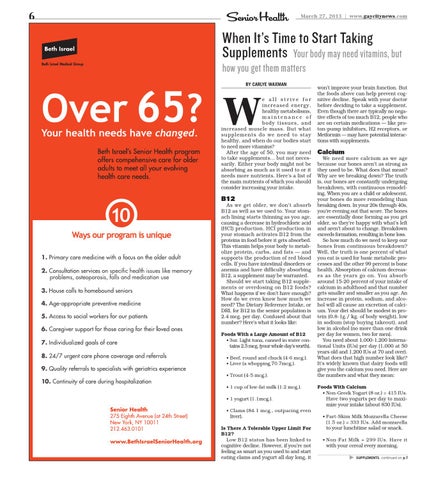6
March 27, 2013 | www.gaycitynews.com
When It’s Time to Start Taking Supplements Your body may need vitamins, but how you get them matters BY CARLYE WAXMAN
W
e all strive for i n c r e a s e d e n e rg y , healthy metabolisms, maintenance of body tissues, and increased muscle mass. But what sup p l em ents d o w e ne e d t o s t ay healthy, and when do our bodies start to need more vitamins? After the age of 50, you may need to take supplements… but not necessarily. Either your body might not be absorbing as much as it used to or it needs more nutrients. Here’s a list of the main nutrients of which you should consider increasing your intake.
B12
As we get older, we don’t absorb B12 as well as we used to. Your stomach lining starts thinning as you age, causing a decrease in hydrochloric acid (HCl) production. HCl production in your stomach activates B12 from the proteins in food before it gets absorbed. This vitamin helps your body to metabolize protein, carbs, and fats — and supports the production of red blood cells. If you have intestinal disorders or anemia and have difficulty absorbing B12, a supplement may be warranted. Should we start taking B12 supplements or overdosing on B12 foods? What happens if we don’t have enough? How do we even know how much we need? The Dietary Reference Intake, or DRI, for B12 in the senior population is 2.4 mcg. per day. Confused about that number? Here’s what it looks like: Foods With a Large Amount of B12 • 3oz. Light tuna, canned in water contains 2.5 mcg. (your whole day’s worth). • Beef, round and chuck (4-6 mcg.). • Liver (a whopping 70.7mcg.). • Trout (4-5 mcg.). • 1 cup of low-fat milk (1.2 mcg.). • 1 yogurt (1.1mcg.). • Clams (84.1 mcg., outpacing even liver). Is There A Tolerable Upper Limit For B12? Low B12 status has been linked to cognitive decline. However, if you’re not feeling as smart as you used to and start eating clams and yogurt all day long, it
won’t improve your brain function. But the foods above can help prevent cognitive decline. Speak with your doctor before deciding to take a supplement. Even though there are typically no negative effects of too much B12, people who are on certain medications — like proton-pump inhibitors, H2 receptors, or Metformin — may have potential interactions with supplements.
Calcium
We need more calcium as we age because our bones aren’t as strong as they used to be. What does that mean? Why are we breaking down? The truth is, our bones are constantly undergoing breakdown, with continuous remodeling. When you are a child or adolescent, your bones do more remodeling than breaking down. In your 20s through 40s, you’re evening out that score. The bones are essentially done forming as you get older, so they’re happy with what’s left and aren’t about to change. Breakdown exceeds formation, resulting in bone loss. So how much do we need to keep our bones from continuous breakdown? Well, the truth is one percent of what you eat is used for basic metabolic processes and the other 99 percent is bone health. Absorption of calcium decreases as the years go on. You absorb around 15-20 percent of your intake of calcium in adulthood and that number gets smaller and smaller as you age. An increase in protein, sodium, and alcohol will all cause an excretion of calcium. Your diet should be modest in protein (0.8-1g./ kg. of body weight), low in sodium (stop buying takeout), and low in alcohol (no more than one drink per day for women, two for men). You need about 1,000-1,200 International Units (IUs) per day (1,000 at 50 years old and 1,200 IUs at 70 and over). What does that high number look like? It’s widely known that dairy foods will give you the calcium you need. Here are the numbers and what they mean: Foods With Calcium • Non-Greek Yogurt (8 oz.) = 415 IUs. Have two yogurts per day to maximize your intake (about 830 IUs). • Part-Skim Milk Mozzarella Cheese (1.5 oz.) = 333 IUs. Add mozzarella to your lunchtime salad or snack. • Non-Fat Milk = 299 IUs. Have it with your cereal every morning.
c
SUPPLEMENTS, continued on p.7
